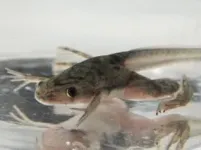Scientists discover new genetic disease that delays brain development in children
2021-03-31
(Press-News.org) Scientists have discovered a new genetic disease, which causes some children's brains to develop abnormally, resulting in delayed intellectual development and often early onset cataracts.
The majority of patients with the condition, which is so new it doesn't have a name yet, were also microcephalic, a birth defect where a baby's head is smaller than expected when compared to babies of the same sex and age.
Researchers from the universities of Portsmouth and Southampton found that changes in a gene called coat protein complex 1 (COPB1) caused this rare genetic disease.
Now the variant has been identified, it will help clinicians come up with targeted interventions to help patients and their families, also opening the door to screening and prenatal diagnosis.
The research team, made up of frog geneticists, medical genomic research scientists and clinical geneticists, sequenced the DNA of affected patients and their family members, which identified COPB1 as the potential underlying cause of the disease. Using tadpoles to mimic the human gene variants, the tadpoles with the COPB1 gene changes had variably smaller brains than the control tadpoles and many of them had cataracts, just like the patients. This showed the link between the gene and disease very clearly.
The findings are published in the journal Genome Medicine.
Study co-author Professor Matt Guille, who leads a laboratory in the Epigenetics and Developmental Biology research group at the University of Portsmouth, said: "This is the first time that the tadpole has been used in such a direct way to help solve a clinical challenge.
"In our initial experiments to test the link between a genetic variation and a disease we found to our surprise that by altering the DNA of tadpoles, four times out of five we could re-create the disease-related changes seen in human patients. This will allow us to support our colleagues in providing more timely, accurate diagnosis that patients and their families so desperately need."
Co-author Diana Baralle, Professor of Genomic medicine and a clinical geneticist at the University of Southampton, said: "Next generation sequencing is transforming our ability to make new diagnoses and discover new causes for rare disorders. This story started with sisters I saw in clinic without a known underlying cause for their signs and symptoms. Looking closely at their genes, along with further functional molecular work and xenopus studies, we saw that this was a new previously undescribed syndrome. A diagnosis is so important to the family."
One in 17 people will suffer from a rare disease at some time in their lives. Most of these rare diseases have a genetic cause and often affect children, but proving which gene change causes a disease is a huge challenge.
Professor Guille said that previously, while studies connecting a gene and a disease were mainly performed in mice; several labs, including his own at the University of Portsmouth, have recently shown that experiments in tadpoles can also provide very strong evidence about the function of variant human genes. The process of re-creating some gene variants in tadpoles is straightforward and can be done in as little as three days.
Professor Guille added: "We now need to extend and improve our technology to make it applicable to the wider range of disease-related DNA changes provided to us by our clinical collaborators.
"If the clinical researchers find the information sufficiently useful, then we will continue to work together to scale up the pipeline of gene function analysis so it can be used to direct effective interventions for a significant number of patients."
INFORMATION:
[Attachments] See images for this press release:

ELSE PRESS RELEASES FROM THIS DATE:
2021-03-31
A new study examining how people with severe and profound intellectual disabilities resist activities while in care recommends that institutions improve training to help carers better understand non-verbal cues, as well as offer greater flexibility to allow individual preferences to take priority over institutional schedules.
The research, published in the journal Sociology of Health and Illness, investigated how people with limited language ability expressed their wishes and preferences, and how their support workers responded. It was carried out at a residential home and a day care centre in the UK.
The study, by Dr Clare Nicholson of St Mary's University, Twickenham, and Dr Mick ...
2021-03-31
In the run up to hibernation, grizzly bears go on a colossal binge, consuming as many calories as possible to get them through the long winter. Yet, little was known about how much energy the massive mammals use as they shamble around their rugged territories. 'Moving across the landscape in search of food can be a huge energetic expense for some animals', Carnahan says. Fortunately, the Washington State University Bear Research, Education and Conservation Center (WSU BREC), where Carnahan is based, is home to 11 bears, including four that formerly lived in Yellowstone National Park, so he and Charles Robbins (also at WSU BREC) decided to measure the animals' metabolic rates as they sauntered on the flat, and up and down gradients to find out how much ...
2021-03-31
New research published in Anaesthesia (a journal of the Association of Anaesthetists) challenges the guidance that special aerosol precautions are only needed when using oxygen therapies for COVID-19 patients, and raises concerns about safety of staff and patients on hospital wards, if they are not protected from infectious aerosols.
The study set out to examine whether oxygen therapies used for patients with severe COVID-19 produce large amounts of small respiratory particles called aerosols, which can transmit virus and can evade routine precautions used on hospital wards. ...
2021-03-31
Rock art of human figures created over thousands of years in Australia's Arnhem Land has been put through a transformative machine learning study to analyse style changes over the years.
The study has tested different styles labelled 'Northern Running figures', 'Dynamic figures', 'Post Dynamic figures' and 'Simple figures with Boomerangs' to understand how these styles relate to one another.
Working with the Mimal and Marrku Traditional Owners of the Wilton River area in Australia's Top End, South Australian researchers led by Flinders University archaeologist Dr Daryl Wesley have taken a closer look at the art of this region.
Flinders researcher Jarrad Kowlessar and the team used machine learning ...
2021-03-31
Highlights
A newly developed tool assesses patients' home dialysis experience.
The 26-item Home Dialysis Care Experience instrument will be a resource for future research use, clinical care, and quality improvement initiatives among home dialysis facilities and organizations.
Washington, DC (March 30, 2021) -- Researchers have developed a new tool to assess patients' opinions and experience concerning home dialysis care. The tool is described in an upcoming issue of CJASN.
Home dialysis, which includes both peritoneal dialysis and home hemodialysis, allows patients to receive their dialysis treatments at home, gives patients independence and flexibility ...
2021-03-30
BOSTON - COVID-19 can have damaging effects on multiple organs in the body, including the brain. A new study led by investigators at Massachusetts General Hospital (MGH) and Beth Israel Deaconess Medical Center (BIDMC) indicates that some hospitalized patients with COVID-19 experience non-convulsive seizures, which may put them at a higher risk of dying. The findings are published in the Annals of Neurology.
"Seizures are a very common complication of severe critical illness. Most of these seizures are not obvious: Unlike seizures that make a person fall down and shake, or convulse, ...
2021-03-30
HOUSTON - (March 30, 2021) - Whether parents prefer a conformance-oriented or independence-oriented supplemental education program for their children depends on political ideology, according to a study of more than 8,500 American parents by a research team from Rice University and the University of Texas at San Antonio.
"Conservative parents have a higher need for structure, which drives their preference for conformance-oriented programs," said study co-author Vikas Mittal, a professor of marketing at Rice's Jones Graduate School of Business. "Many parents ...
2021-03-30
Boulder, Colo., USA: Anthropogenic climate change is one of the foremost scientific and societal challenges. In part, our response to this global challenge requires an enhanced understanding of how the Earth's surface responds to episodes of climatic heating and cooling. As historical records extend back only a few hundred years, we must look back into the ancient rock record to see how the surface of the Earth has responded to shifts between icehouse (presence of ice at the Earth's poles) and greenhouse (no substantial ice at Earth's poles) climates in the past.
In ...
2021-03-30
NEW YORK, NY (March 30, 2021)--Early in the pandemic, neurologists expressed concern that COVID-19 patients with dementia may be at higher risk for complications and mortality.
But those fears have not been realized, according to a new study of patients who were hospitalized with COVID-19 during the first wave of the pandemic in New York City. The study, led by James Noble, MD, MS, associate professor of neurology at Columbia University Vagelos College of Physicians and Surgeons and the Taub Institute for Research on Alzheimer's Disease and the Aging Brain, and Amro Harb, a Vagelos medical student, was published this month in ...
2021-03-30
A year ago scientists everywhere were scrambling to get their minds around the SARS-CoV-2, a novel coronavirus that caused the pandemic from which we are only now beginning to emerge. The world clung to every new development, every bit of science that could provide clues to managing life in the presence of this mysterious killer.
Many science-backed COVID-19 management concepts remain unchanged to this day: handwashing with soap and warm water disrupts the virus' lipid membrane. Social distancing can attenuate the virus's spread, ideally keeping it out of a host until it degrades. Other notions, such as droplet contact being the primary mode of transmission, were modified when emerging evidence showed that under ...
LAST 30 PRESS RELEASES:
[Press-News.org] Scientists discover new genetic disease that delays brain development in children

